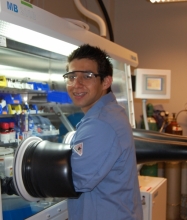
Major:
University:
Mentor(s):
Faculty Sponsor(s):
Faculty Sponsor's Department(s):
Project Title:
Project Description:
Organic photovoltaics (OPVs) have received widespread attention in recent years as a promising source of renewable energy. In contrast to their inorganic counterparts, OPVs can be solution deposited over large surface areas at temperatures compatible with plastics processing to yield thin, flexible, light-weight devices which demonstrate potential for reduced production costs. While numerous organic semiconductors and processing techniques have been extensively researched, the influence of polymer/fullerene miscibility on the bulk heterojunction’s microstructure, charge carrier mobilities, and active layer electronic activity is still an area of intense interest. Here we present a series of ternary blend OPVs utilizing a system of two dissimilar fullerene molecules designed to exploit the bulk heterojunction’s microstructure to enhance charge separation and transport. Ternary blend OPVs and their active layers are compared to a baseline supported by well-researched, poly(3- hexylthiophene-2,5-diyl):phenyl-C61-butyric acid methyl ester P3HT:PCBM reference device controls. The ternary blends are based on d-f-PCBM (a low surface-energy PCBM derivative), d-bis-PCBM (an amorphous, high LUMO PCBM derivative), and P3HT. The ternary blends are analyzed via I-V plots for Power Conversion Efficiency (PCE), External Quantum Efficiency (EQE), and Dynamic Secondary Ion Mass Spectrometry to investigate the influence of fullerene composition on bulk microstructure and device performance. PCE and EQE results of the ternary blend devices suggest the band gaps of the dissimilar fullerenes interact with each other for a linear increase in the open circuit voltage (Voc), suggesting an organic-alloying effect.
